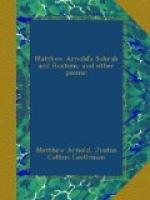=17. Muses.= See note, l. 120, The Strayed Reveller.
=18. In their cool gallery=. That is, in the Vatican art gallery at Rome.
=19. yellow Tiber.= So called by the ancients because
of the yellowish, muddy appearance of its waters.
[178]
=21. Strange unloved uproar.= At the time this
poem was written,—1849,—the
French army was besieging Rome.
=23. Helicon.= High mountain in Boeotia, legendary home of the Muses.
=32. Erst.= See note, l. 32, The Scholar-Gipsy.
=48. Destiny.= That is, Fate, the goddess of human destiny.
In what mood is the author at the opening of the poem? How does he seek consolation? How does the calm of the Muses affect him? Can you see how he might find help in dwelling on the pictures of the blind beggar and happy lovers? What is the final thought of the poem? Can you think of any other poem that has this as its central thought? What do you think of the author’s philosophy of life as set forth in this poem? Discuss the verse form used.
LINES
WRITTEN IN KENSINGTON GARDENS
The Kensington Gardens form one of the many beautiful public parks of London. They are located in the Kensington parish, a western suburb of the city, lying north of the Thames and four miles west-southwest of St. Paul’s. In his poem Arnold contrasts the serenity of nature with the restlessness of modern life. “Not Lucan, not Vergil, only Wordsworth, has more beautifully expressed the spirit of Pantheism.”—HERBERT W. PAUL.
=4.= The pine trees here mentioned are since dead.
=14. What endless active life!= Compare with Arnold’s sonnet of this volume, entitled Quiet Work, ll. 4-7 and 11-12.
=21. the huge world.= London.
=24. Was breathed on by rural Pan.= Note Arnold’s
classic way of
accounting for his great love for nature, Pan being
the nature god.
See note, l. 67, The Strayed Reveller.
[179]
=37-42.= Compare the thought here presented with the
following lines
from Wordsworth:—
“These beauteous forms,
... have not been to me
As is a landscape to a blind man’s eye.
But oft, in lonely rooms, and ’mid the din
Of towns and cities, I have owed to them,
... sensations sweet
Felt in the blood, and felt along the heart;
And passing even into my purer mind,
With tranquil restoration.”
Read also Wordsworth’s Lines to the Daffodil.
What is the dominant mood of the poem? What evidently brought it to the author’s mind? How does he show his interest in nature? In human beings? What inspiration does the author seek from nature, ll. 37-42? Explain the meaning of the last two lines.




